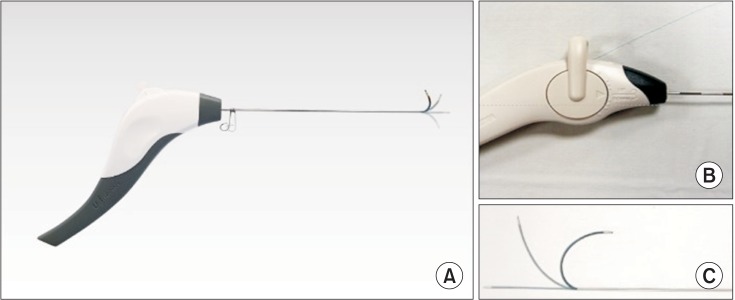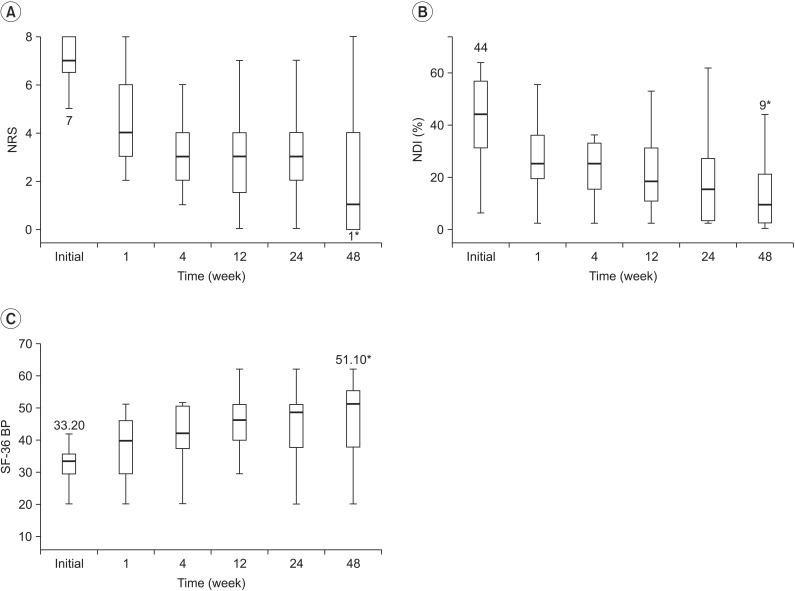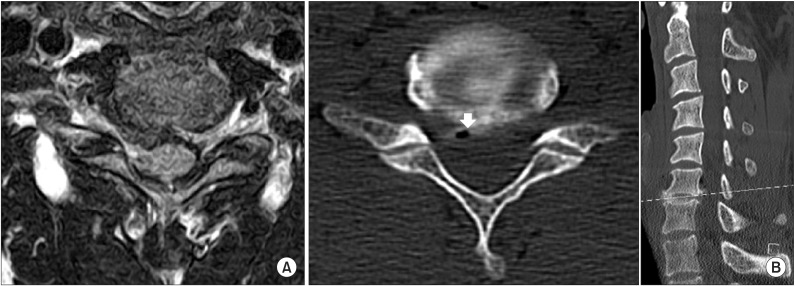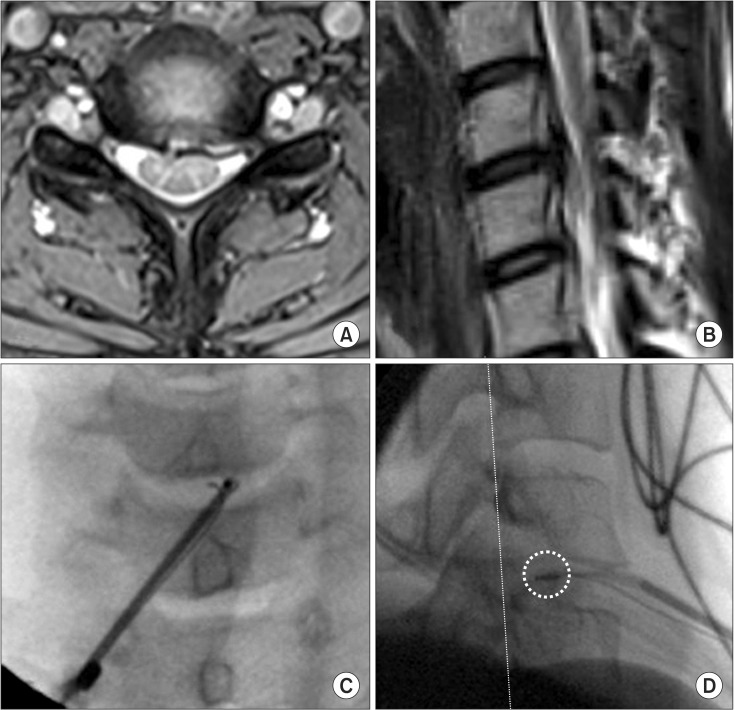Ann Rehabil Med.
2017 Feb;41(1):80-89. 10.5535/arm.2017.41.1.80.
Clinical Efficacy of Selective Focal Ablation by Navigable Percutaneous Disc Decompression Device in Patients With Cervical Herniated Nucleus Pulposus
- Affiliations
-
- 1Department of Physical Medicine and Rehabilitation, Korea University Anam Hospital, Seoul, Korea. spinelee@gmail.com
- 2College of Arts and Sciences, University of Virginia, Charlottesville, VA, USA.
- KMID: 2383681
- DOI: http://doi.org/10.5535/arm.2017.41.1.80
Abstract
OBJECTIVE
To evaluate the clinical efficacy and safety following percutaneous disc decompression, using navigable disc decompression device for cervical herniated nucleus pulposus (HNP).
METHODS
Twenty subjects diagnosed with cervical HNP and refractory to conservative management were enrolled for the study. The herniated discs were decompressed under fluoroscopic guidance, using radiofrequency ablation device with navigable wand. The sagittal and axial plain magnetic resonance images of the clinically significant herniated disc, decided the space between the herniated base and outline as the target area for ablation. Clinical outcome was determined by Numeric Rating Scale (NRS), Neck Disability Index (NDI), and Bodily Pain scale of Short Form-36 (SF-36 BP), assessed after 48 weeks. After the procedure, we structurally matched the magnetic resonance imaging (MRI) and C-arm images through bony markers. The wand position was defined as being "˜correct' if the tip was placed within the target area of both AP and lateral views; if not, the position was stated as "˜incorrect'.
RESULTS
The average NRS fell from 7 to 1 at 48 weeks post procedure (p<0.05). In addition, statistically significant improvement was noted in the NDI and SF-36BP (p<0.05). The location of the wand tip resulted in 16 correct and 4 incorrect placements. Post-48 weeks, 3 of the incorrect tip cases and 1 correct tip case showed unsuccessful outcomes.
CONCLUSION
The study demonstrated the promising results and safety of the procedure. Thus, focal plasma ablation of cervical HNP with navigable wand can be another effective treatment option.
MeSH Terms
Figure
Reference
-
1. Hoy DG, Protani M, De R, Buchbinder R. The epidemiology of neck pain. Best Pract Res Clin Rheumatol. 2010; 24:783–792. PMID: 21665126.
Article2. Radhakrishnan K, Litchy WJ, O'Fallon WM, Kurland LT. Epidemiology of cervical radiculopathy: a population-based study from Rochester, Minnesota, 1976 through 1990. Brain. 1994; 117(Pt 2):325–335. PMID: 8186959.3. Bilston LE, Thibault LE. The mechanical properties of the human cervical spinal cord in vitro. Ann Biomed Eng. 1996; 24:67–74. PMID: 8669719.4. Lu J, Ebraheim NA, Huntoon M, Haman SP. Cervical intervertebral disc space narrowing and size of intervertebral foramina. Clin Orthop Relat Res. 2000; (370):259–264.
Article5. Graham JJ. Complications of cervical spine surgery. A five-year report on a survey of the membership of the Cervical Spine Research Society by the Morbidity and Mortality Committee. Spine(Phila Pa 1976). 1989; 14:1046–1050. PMID: 2588051.6. Nasser R, Yadla S, Maltenfort MG, Harrop JS, Anderson DG, Vaccaro AR, et al. Complications in spine surgery. J Neurosurg Spine. 2010; 13:144–157. PMID: 20672949.
Article7. Gebremariam L, Koes BW, Peul WC, Huisstede BM. Evaluation of treatment effectiveness for the herniated cervical disc: a systematic review. Spine (Phila Pa 1976). 2012; 37:E109–E118. PMID: 21587105.8. Hijikata S. Percutaneous nucleotomy: a new concept technique and 12 years' experience. Clin Orthop Relat Res. 1989; (238):9–23.9. Karasek M, Bogduk N. Twelve-month follow-up of a controlled trial of intradiscal thermal anuloplasty for back pain due to internal disc disruption. Spine (Phila Pa 1976). 2000; 25:2601–2607. PMID: 11034644.
Article10. Chen YC, Lee SH, Saenz Y, Lehman NL. Histologic findings of disc, end plate and neural elements after coblation of nucleus pulposus: an experimental nucleoplasty study. Spine J. 2003; 3:466–470. PMID: 14609691.
Article11. Lee MS, Cooper G, Lutz GE, Doty SB. Histologic characterization of coblation nucleoplasty performed on sheep intervertebral discs. Pain Physician. 2003; 6:439–442. PMID: 16871295.12. Lee SH, Derby R, Sul Dg, Hong Jw, Kim GH, Kang S, et al. Efficacy of a new navigable percutaneous disc decompression device (L'DISQ) in patients with herniated nucleus pulposus related to radicular pain. Pain Med. 2011; 12:370–376. PMID: 21332936.
Article13. Schellhas KP, Smith MD, Gundry CR, Pollei SR. Cervical discogenic pain: prospective correlation of magnetic resonance imaging and discography in asymptomatic subjects and pain sufferers. Spine (Phila Pa 1976). 1996; 21:300–312. PMID: 8742205.14. Campbell PG, Yadla S, Malone J, Zussman B, Maltenfort MG, Sharan AD, et al. Early complications related to approach in cervical spine surgery: single-center prospective study. World Neurosurg. 2010; 74:363–368. PMID: 21492571.
Article15. Hodges SD, Humphreys SC, Brown TW Jr, Eck JC, Covington LA. Complications of the anterior retropharyngeal approach in cervical spine surgery: a technique and outcomes review. J South Orthop Assoc. 2000; 9:169–174. PMID: 12135298.16. Birnbaum K. Percutaneous cervical disc decompression. Surg Radiol Anat. 2009; 31:379–387. PMID: 19190848.
Article17. Lee SH, Ahn Y, Choi WC, Bhanot A, Shin SW. Immediate pain improvement is a useful predictor of long-term favorable outcome after percutaneous laser disc decompression for cervical disc herniation. Photomed Laser Surg. 2006; 24:508–513. PMID: 16942433.
Article18. Knight MT, Goswami A, Patko JT. Cervical percutaneous laser disc decompression: preliminary results of an ongoing prospective outcome study. J Clin Laser Med Surg. 2001; 19:3–8. PMID: 11547816.
Article19. Richaud J, Lazorthes Y, Verdie JC, Bonafe A. Chemonucleolysis for herniated cervical disc. Acta Neurochir (Wien). 1988; 91:116–119. PMID: 2457297.
Article20. Castro WH, Halm H, Rondhuis J. The influence of automated percutaneous lumbar discectomy (APLD) on the biomechanics of the lumbar intervertebral disc. An experimental study. Acta Orthop Belg. 1992; 58:400–405. PMID: 1485502.21. Li J, Yan DL, Gao LB, Tan PX, Zhang ZH, Zhang Z. Comparison percutaneous cervical disc nucleoplasty and cervical discectomy for the treatment of cervical disc herniation. Zhonghua Wai Ke Za Zhi. 2006; 44:822–825. PMID: 16889729.
- Full Text Links
- Actions
-
Cited
- CITED
-
- Close
- Share
- Similar articles
-
- Application of Percutaneous Cervical Nucleoplasty Using the Navigable Disc Decompression Device in Patient of Cervical Herniated Intervertebral Disc: A Case Report
- Percutaneous LASER Disc Decompression for Lumbar Disc Herniations: Preliminary Report
- Histological Composition of the Extruded Intervertebral Disc in Lumbar Intervertebral Disc Herniation
- Regression of Herniated Nucleus Pulposus after Anterior Interbody Fusion
- Sonographic evaluation of herniated lumbar disc






